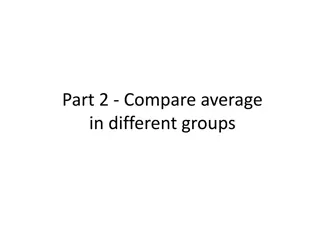Detector Building
Teams will construct a durable Oxidation Reduction Potential (ORP) probe to measure voltage and NaCl concentrations in water samples. Participants will complete a written test on the event's principles and theories. The competition involves building the device using microcontrollers, sensors, and di
2 views • 15 slides
Understanding Survey Data Analysis in SAS: Methods and Applications
Explore the nuances of survey data analysis in SAS, covering topics such as populations and samples, complex survey samples, stratified sampling, and more. Learn how to ensure representativeness in sampling and optimize precision of estimates in survey studies.
0 views • 31 slides
Practical Aspects of Taking Cervical Samples: Guidance for Sample Takers
This guidance covers practical aspects of taking cervical samples, including preparing the environment, essential equipment, checking patient identity, and effective communication skills for sample takers to provide information and answer questions. It emphasizes the importance of a warm, well-lit,
7 views • 49 slides
Understanding Non-Probability Sampling Methods
Non-probability sampling methods involve selecting samples based on subjective judgment rather than random selection. Types include convenience sampling, quota sampling, judgmental (purposive) sampling, and snowball sampling. Convenience sampling picks easily available samples, quota sampling select
4 views • 7 slides
Enfield Advocacy Services Overview
Enfield Advocacy Services, provided by POhWER, offer various advocacy programs including Independent Care Act Advocacy (ICAA), Independent Health Complaints Advocacy (IHCA), and Independent Mental Capacity Advocacy (IMCA) among others. The services aim to support individuals in understanding and par
1 views • 26 slides
Systematic Analysis of Real Samples in Analytical Chemistry
This analysis covers the systematic process involved in analyzing real samples, including sampling, sample preservation, and sample preparation. It discusses the importance of accurate sampling in obtaining information about various substances, such as solids, liquids, gases, and biological material
0 views • 54 slides
Introduction to Sampling in Statistics
Sampling in statistics involves selecting a subset of individuals from a population to gather information, as it is often impractical to study the entire population. This method helps in estimating population characteristics, although it comes with inherent sampling errors. Parameters represent popu
2 views • 24 slides
Mastering PTE Academic Speaking_ Retell Lecture Samples and Strategies
Wrapping Up\n\nMastering the Retell Lecture task in the PTE Academic Speaking section is all about practice and strategy. By honing your listening skills, structuring your responses effectively, and using the provided samples as a guide, you\u2019ll
0 views • 3 slides
Spectrophotometric Determination of Cr and Mn in Steel Samples
This experiment aims to determine the concentrations of manganese and chromium in steel samples by converting Cr3+ and Mn2+ ions to light-absorbing forms, followed by spectrophotometric measurements at specific wavelengths. Steel samples are oxidized, dissolved, and further oxidized to form dichroma
0 views • 10 slides
Effective Memo Samples for Parking and Break Time Policies
These memo samples address parking concerns due to limited space and break time violations in the workplace. Daniel Smith and Anne Henderson effectively communicate the need for cooperation and adherence to the specified rules to ensure smooth operations.
0 views • 5 slides
Depth Profile Analysis of Fusion-Relevant Samples Using LIBS Technique
Analysis of fusion-relevant samples through Laser-Induced Breakdown Spectroscopy (LIBS) is conducted at Comenius University. The study compares picosecond (ps) and nanosecond (ns) regimes in depth profiling and quantification of tungsten-based coatings and other fusion materials. The research also i
0 views • 8 slides
Understanding Sampling Methods and Errors in Research
Sampling is crucial in research to draw conclusions about a population. Various methods like simple random sampling, stratified sampling, and systematic sampling help in selecting representative samples. Sampling error arises due to differences between sample and population values, while bias leads
0 views • 12 slides
ELECTRA: Pre-Training Text Encoders as Discriminators
Efficiently learning an encoder that classifies token replacements accurately using ELECTRA method, which involves replacing some input tokens with samples from a generator instead of masking. The key idea is to train a text encoder to distinguish input tokens from negative samples, resulting in bet
0 views • 12 slides
Bacteriological Analysis of Drinking Water by MPN Method in Microbiology Class III
This study focuses on the bacteriological analysis of drinking water using the Most Probable Number (MPN) method in a microbiology class. The MPN method involves enumerating and identifying bacteria in drinking water samples through a series of tests including presumptive, confirmed, and completed t
0 views • 13 slides
Sampling Methods and Requirements for Water and Wastewater Analysis
The collection of water and wastewater samples is crucial for accurate analysis and monitoring. Understanding the reasons for sampling, different methods, and the importance of sample preparation is essential for obtaining reliable results. Planning sampling, meeting specific requirements, and selec
6 views • 22 slides
Understanding Basic Concepts in Statistics
This content covers fundamental concepts in statistics such as populations, samples, models, and probability distributions. It explains the differences between populations and samples, the importance of models in describing populations, and discusses various distributions like the normal and Poisson
0 views • 42 slides
Understanding Independent Samples t-Test in Statistical Analysis
The independent samples t-test is used to compare means in a between-groups design where each participant is in only one condition. It involves sets of participant scores that are independent, meaning they are completely unrelated to each other. This test helps to determine if there is a significant
1 views • 32 slides
Solving the Murder of Mrs. Mary Smith: An Interactive Investigation Experience
Dive into a thrilling murder mystery as you help solve the case of Mrs. Mary Smith's tragic death. Explore evidence rooms, analyze fingerprints, hair samples, soil samples, and chemical details to unravel the mystery. Follow the clues, watch videos, and conduct interviews to uncover the truth behind
5 views • 17 slides
IL-NET: Training and Technical Assistance for Independent Living
IL-NET, a project of ILRU, provides training and technical assistance for independent living centers. The presentation covers creating and maintaining consumer files, Information and Referral processes, consumer signature requirements, Independent Living Plans, evaluation feedback, accessibility rem
0 views • 25 slides
Making the Move to Independent Housing in Northern Virginia
Explore the journey to independent housing with the Northern Virginia Housing & Supportive Services Regional Implementation Team. Discover the choices and responsibilities that come with independent living through interactive games and insights into success stories. Learn about the offerings, respon
0 views • 26 slides
Navigating Statistical Inference Challenges in Small Samples
In small samples, understanding the sampling distribution of estimators is crucial for valid inference, even when assumptions are violated. This involves careful consideration of normality assumptions, handling non-linear hypotheses, and computing standard errors for various statistics. As demonstra
0 views • 19 slides
gNB Positioning Measurement Requirements Discussion at 3GPP TSG-RAN WG4 Meeting
Discussion at the 3GPP TSG-RAN WG4 meeting #98bis-e focused on gNB positioning measurement requirements, including beam sweeping, gNB accuracy requirements, samples for gNB accuracy, RoAoA side conditions, and SRS-RSRP measurement accuracy requirements. The meeting addressed various candidate option
1 views • 14 slides
Comparative Study of Soil Samples from Gottigere Lake and Madiwala Lake
This study compares the soil samples from Gottigere Lake and Madiwala Lake in Bangalore, India, analyzing macronutrients, micronutrients, and indicator species to assess pollution levels. The research aims to contribute to wetland conservation and ecosystem-based climate change adaptation.
0 views • 32 slides
Limitations of Deep Learning in Adversarial Settings
Deep learning, particularly deep neural networks (DNNs), has revolutionized machine learning with its high accuracy rates. However, in adversarial settings, adversaries can manipulate DNNs by crafting adversarial samples to force misclassification. Such attacks pose risks in various applications, in
0 views • 38 slides
Agglutination Testing in Laboratory Medicine
Agglutination testing is a common method used in laboratory medicine to detect the presence and amount of antigens or antibodies in patient samples. It involves the use of carrier particles such as latex, RBCs, charcoal, and protein A of Staph aureus. The testing process includes qualitative and qua
0 views • 18 slides
The Role of Independent Directors in Corporate Governance: A Critical Evaluation
The role of independent directors in corporate governance is critically evaluated in this content, addressing the effectiveness and limitations of independent boards in addressing governance issues. The history and rise of independent directors, empirical research on their effects, and the importanc
0 views • 31 slides
Empowering Nevadans with Disabilities: The Nevada SILC Mission
The Nevada State Independent Living Council (SILC) advocates for empowering individuals with disabilities to live independently in the community. Their mission focuses on promoting the philosophy of independent living and maximizing leadership, empowerment, and inclusion. The Council is federally fu
0 views • 14 slides
Computation on Graphs: Maximal Independent Sets
The content discusses the concept of maximal independent sets in graph theory. It defines independent, maximal, and maximum sets, highlighting the difficulty in finding a maximum independent set due to its NP-hard nature. Sequential and parallel algorithms for finding maximal independent sets are pr
0 views • 12 slides
Understanding Complex Sentences in English Grammar
Complex sentences consist of an independent clause along with one or more dependent clauses. The independent clause can stand alone, while the dependent clauses rely on the independent clause for meaning. Differentiating between independent and dependent clauses is essential in understanding how com
0 views • 15 slides
Understanding Independent Paths and Cut Sets in Graph Theory
Independent paths and cut sets play a crucial role in graph theory, determining connectivity and flow rates in networks. Learn about edge-independent paths, vertex-independent paths, connectivity, cut sets, Menger's theorem, and the Max-flow/min-cut theorem, with practical examples and implications.
0 views • 10 slides
Update on May 2019 IBA Activities
The May 2019 update by IBA includes information on market trends, independent beer industry growth, the rollout of the Independent Seal, important events like Good Beer Week, and valuable resources for members. Key points include a decline in total beer consumption, significant growth in the indepen
0 views • 20 slides
Comparing Average in Different Groups: Paired vs. Independent Samples
In statistical analysis, comparing averages in different groups is essential for various research scenarios. This involves distinguishing between paired observations and independent samples, leading to different t-tests for analysis. Understanding these concepts is crucial for making accurate compar
0 views • 112 slides
Understanding Types of Sentences in English Grammar
Types of sentences in English grammar include clauses - independent and dependent. Independent clauses stand alone, expressing complete thoughts, while dependent clauses rely on independent clauses. Different types of sentences include simple, compound, complex, and compound/complex sentences. Simpl
0 views • 41 slides
Study on the Thermal and Chemical Properties of Polymer-Cement Composites
The study investigates the resistance of polymer-cement composites to thermal stress and chemical attacks such as acidic and high CO2 environments. Results show similar color changes in control cement and polymer-cement composites after thermal stress, with the latter maintaining compressive strengt
0 views • 5 slides
Analytical Toxicology: Techniques and Sample Analysis in Clinical Toxicology
Analytical toxicology involves the observation, identification, and measurement of foreign compounds in biological and other samples, such as urine, blood, stomach contents, nails, hair, and DNA. Various techniques are used to isolate and identify drugs and poisons present in these samples. This fie
0 views • 12 slides
Utilizing Different Samples for Diagnostic Testing in Medicine
The practice of diagnostic testing in medicine goes beyond blood and stool samples. Gathering urine samples, for example, allows healthcare providers to assess various health aspects, such as kidney function, urinary tract infections, diabetes, and more. By examining the color, clarity, odor, densit
0 views • 21 slides
Quality Assurance Sampling Protocols for Flower Lots under WAC 314-55-101
Quality assurance sampling protocols for flower lots under WAC 314-55-101 dictate that at least 4g of flower lot samples are required, with procedures outlining the deduction of four separate samples from different quadrants of the lot to ensure representativeness. The WSLCB Traceability system enfo
0 views • 4 slides
Ensuring Chain of Evidence Integrity in Cargo Sampling
The chain of evidence is crucial in cargo sampling to establish a direct link between declared cargo, samples taken, and analyst's findings. This involves physical measures like identification of goods and representative samples, as well as documentary measures such as examination accounts and labor
0 views • 13 slides
Designing a Controlled Experiment: Steps and Considerations
Experimental design involves systematically testing hypotheses by manipulating independent variables and measuring their effects on dependent variables. This process includes considering variables, designing treatments, assigning subjects to groups, and planning measurements. To ensure valid conclus
0 views • 11 slides
Introduction to Independent Sample Means T-Test in Educational and Psychological Research
Independent Sample Means T-Test is a statistical analysis used to compare the means of two independent groups to determine if there is a significant difference between them. This test is commonly used in educational and psychological research to assess the effectiveness of interventions or treatment
0 views • 21 slides







































